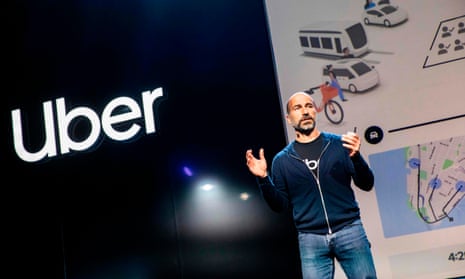Uber has announced a slew of updates to its app – including consolidating its food delivery and ride-hailing services, and a new feature highlighting local public transportation options – in a bid to create “an operating system for everyday life”.
Uber announced the more than 25 changes to its platform at a launch event in San Francisco on Thursday. Among the tech company’s most significant moves will be merging its ride-hailing app and food-delivery app Uber Eats, and offering users alternative travel information including bikes, scooters, public transportation, and even helicopters in some locations.
“We recognize that becoming an integral part of people’s lives comes with real responsibility,” Uber CEO Dara Khosrowshahi said. “That’s why we are working to make sure every customer is treated like a VIP, every driver and courier feels like a valued partner, and every city feels like we’re a good citizen.”
When riders search for a destination, they will see travel options listed in order of price, including public transit as well as electric bikes and scooters. This means cheaper options such as subway and bus schedules may appear at the top of the list, and riders can request notifications when trains or buses they track are delayed. The new transit feature is live in Denver and London and will soon be operational in San Francisco, Mexico City, and Paris.
It might seem unexpected for Uber to be guiding users away from taking a car, but the company has long harbored ambitions to become an all-encompassing transit platform.
“To some extent, we’re competing against ourselves,” Khosrowshahi told the Verge of adding public transit options. “But we have the philosophy that if there’s a better product out there for the user, and we think an integrated movement solution is better for the user, we should be the ones competing against ourselves versus others doing it.”
Uber Eats will also open more “digital-only restaurants” – businesses with no brick-and-mortar outlet where customers can only order food from on the app. One digital restaurant comes through a partnership with the celebrity chef Rachael Ray and will be available in 10 cities for 10 weeks exclusively on Uber Eats.
Uber’s big changes come as the company struggles to turn a profit months after it went public in May. In August, Uber cut 400 jobs as it attempted to rein in excessive spending and losses. In August the company reported its largest-ever quarterly loss: $5bn in three months.
Meanwhile, new regulatory hurdles threaten to raise the company’s operating costs by changing how drivers are paid. In the two-hour event, Uber did not mention Assembly Bill 5, a new law passed in September that will upend the way gig economy workers in California, including drivers, are remunerated, as well as the benefits they are entitled to. Uber, its competitor Lyft, and other gig economy startups have announced a plan to fight the bill with a 2020 ballot measure.
In addition to platform integrations and Uber Eats changes, Uber made a number of safety updates to the app. Riders will now use a four-digit PIN to verify they are entering the correct car. Uber said it is developing an “ultrasound wave” technology so in the future the app can automatically verify riders are in the right car without a PIN number.
In the app, riders will now have a “Report Safety Incident” option and the ability to text 911 in case of emergency. The company updated its “real-time ID check” feature introduced in 2016, requiring drivers to take selfies to verify identities. The changes come after Uber was sued for $10m in April by a woman who was sexually assaulted by her driver. A number of women announced last week they were bringing lawsuits against Lyft over drivers sexually assaulting them. The victim in the case against Uber alleges that the company failed to “warn her of the risk its services posed to women”. A CNN report last year found at least 103 Uber drivers in the US had been accused of sexually assaulting or abusing their passengers over a period of four years.
Uber also announced an expansion of its Uber Rewards program, which allows customers to redeem points when taking an Uber ride, ordering Uber Eats, or spending with partner restaurants.
